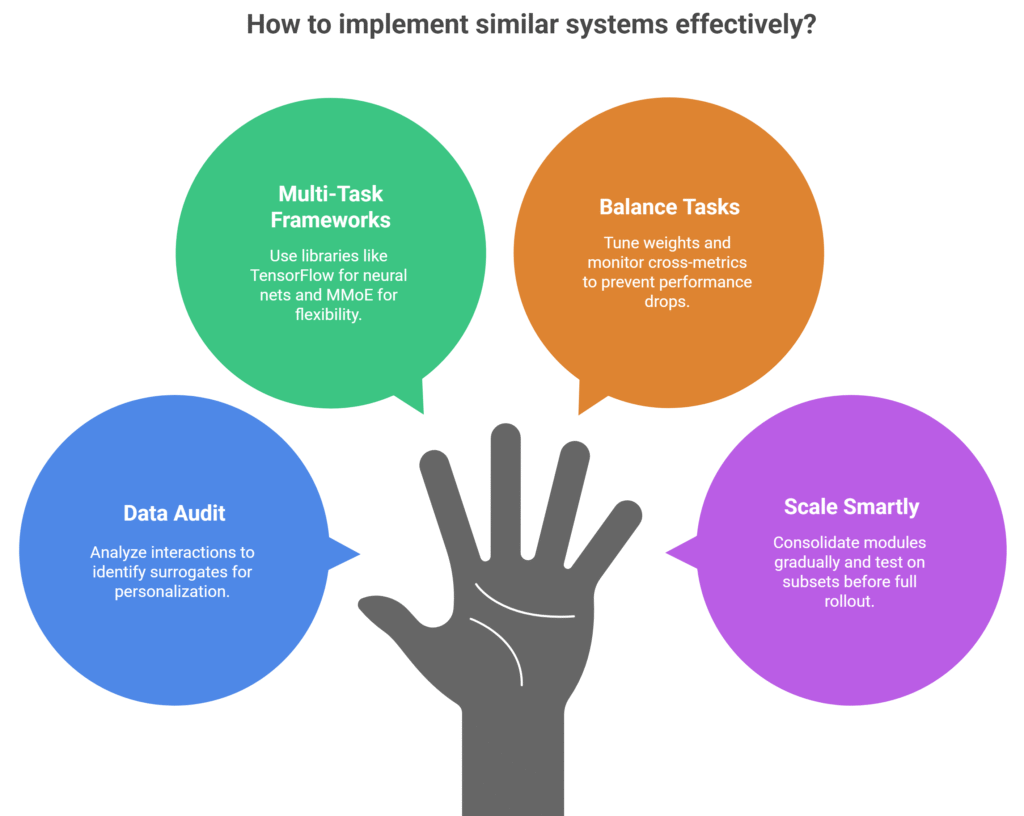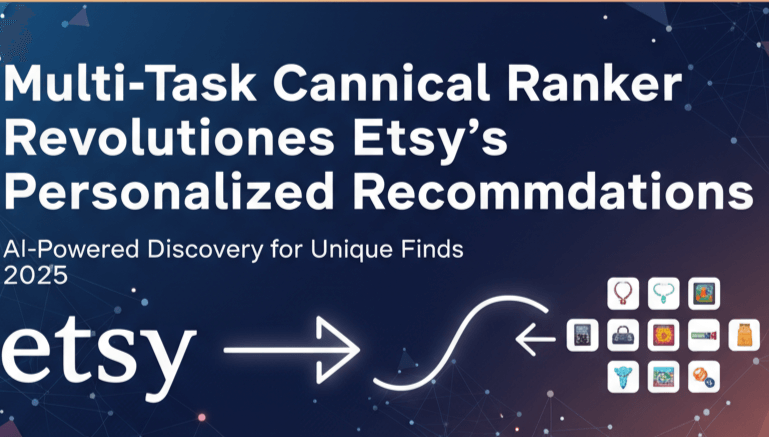Table Of Contents
- The Foundation of Etsy's Recommendation System Architecture
- Why Canonical Rankers Are Revolutionizing Online Marketplaces
- Diving into Multi-Task Learning for Recommendation Engines
- Candidate Set Selection and Ranking in Action on Etsy
- Measuring Success: User Engagement Metrics and Beyond
- Practical Tips for Implementing Similar Systems
- FAQs
- Conclusion: Turning LLM Challenges into Opportunities
Imagine scrolling through an online marketplace filled with over 100 million unique items, and somehow, the perfect handmade necklace or vintage poster pops up just when you need inspiration. That’s the magic of Etsy’s recommendation system at work. But behind those spot-on suggestions lies a sophisticated evolution in tech: the multi-task canonical ranker for Etsy recommendations. This isn’t just another algorithm—it’s a game-changer that helps buyers discover treasures while keeping the platform efficient and engaging.
In this deep dive, we’ll explore how Etsy tackled the challenges of scaling recommendations across hundreds of modules. We’ll break down the architecture, the shift to canonical models, and why this approach is reshaping personalized product recommendations on Etsy. Whether you’re a seller curious about visibility or a tech enthusiast eyeing machine learning item ranking on Etsy, stick around for practical insights, real-world examples, and tips that could apply to your own projects.
The Foundation of Etsy's Recommendation System Architecture
Etsy’s marketplace thrives on connections between buyers and sellers, and recommendations are the bridge. With millions of listings, the system must sift through vast inventories quickly to surface relevant items. This happens in two key phases: candidate set selection and ranking.
First, candidate set selection pulls a small pool of potential items from the entire catalog. Speed is crucial here—think milliseconds—to keep users from bouncing away. Etsy uses efficient retrieval methods to narrow down options based on basic relevance, like category matches or past views.etsy.com
Then comes the ranking phase, where a more advanced model scores these candidates. This is where Etsy’s recommendation system architecture shines, incorporating user context like recent purchases or clicked categories. Features—those data points like item titles, taxonomies, and user behaviors—feed into the model to predict what might catch your eye next.
Historically, Etsy ran separate rankers for each module, like “more from this shop” or “you may also like.” These modules appear everywhere, from homepages to item pages, tailored to shopping stages. But as modules multiplied into hundreds, maintenance became a nightmare. Daily pipelines ballooned, and iterating on features slowed down. Enter canonical rankers for online marketplaces: a unified model that powers multiple modules without sacrificing performance.mckinsey.com
This shift mirrors broader trends in e-commerce. According to a 2023 McKinsey report, personalized recommendations drive up to 35% of sales on platforms like Amazon and Etsy. By consolidating, Etsy not only cuts costs but also ensures consistent experiences across web and mobile.
Why Canonical Rankers Are Revolutionizing Online Marketplaces
Picture this: You’re browsing Etsy after buying a custom mug, and suddenly, complementary items like coasters appear, sparking a new shopping idea. That’s the goal of canonical rankers—models trained on diverse data to handle various contexts seamlessly.
Unlike single-purpose rankers tied to one module, canonical ones optimize for a core metric but generalize across many. Etsy’s first canonical effort focused on visit frequency, aiming to turn one-time shoppers into regulars. Data shows favoriting correlates strongly with returns, so they optimized for favorite rate as a proxy.
But here’s the twist: Favoriting doesn’t always align with buying. To avoid distracting users mid-purchase, Etsy monitored conversion rates closely. This balancing act highlights why canonical rankers for online marketplaces are gaining traction— they reduce engineering overhead while boosting metrics.
In practice, Etsy selected training data from representative modules, accounting for differences like signed-in mobile users versus anonymous desktop browsers. They balanced segments to reflect real behaviors, ensuring the model generalizes. For instance, exploratory app users might favorite more whimsically, while search-driven visitors seek specifics.
Industry patterns support this: A Gartner study predicts that by 2026, 80% of e-commerce platforms will adopt multi-purpose AI models to handle personalization at scale. Etsy’s approach offers a blueprint, showing how to maintain quality amid growth.LinkedIn.com
Diving into Multi-Task Learning for Recommendation Engines
At the heart of Etsy’s innovation is multi-task learning in recommendation engines. Traditional tree-based models couldn’t juggle multiple goals, so they switched to neural networks, which excel at shared architectures.
The model predicts both favorite and purchase probabilities, combining them for a final score. A shared-bottom structure captures common factors—like user interests—while task-specific layers handle nuances. Etsy enhanced this with a Multi-gate Mixture of Experts (MMoE) layer, allowing flexible representations without heavy computation.
Key to making it canonical? Adding a “module_name” feature to every layer, helping the model adapt to context. They even simulated unseen modules by swapping in dummy names for 10% of training data. Weights for interactions (impressions, clicks, favorites, purchases) vary by module, fine-tuned for balance.
This isn’t theory—offline tests on eight modules showed parity or better against old rankers, even for untrained ones. Launches in Q2 2022 on item and homepage modules yielded 12.5% better favorite NDCG (a ranking quality metric) and lifts in purchases and engagement.
For e-commerce pros, here’s a tip: Start small by consolidating similar modules, then expand. Use A/B testing to monitor not just your target metric but secondary ones like bounce rates. Etsy’s case study proves multi-task learning can increase recommendation accuracy by leveraging shared insights.shopify.com
Candidate Set Selection and Ranking in Action on Etsy
Let’s zoom in on how Etsy’s candidate set selection works hand-in-hand with ranking. From 100 million listings, the system retrieves hundreds of candidates using quick heuristics, like similarity searches or collaborative filtering.
Ranking then refines this set with machine learning. Implicit feedback in ranking models—user actions like clicks or adds to cart—trains the system. No explicit ratings needed; behaviors speak volumes.
Etsy’s multi-task canonical ranker uses features like contextual attributes (recent activity) and item attributes (titles, categories). For example, if you’ve clicked jewelry often, it prioritizes similar items but weighs favorites to suggest exploratory picks.
User engagement metrics in recommendation systems are pivotal. Etsy optimizes for favorites as a frequency proxy, but tracks clicks, conversions, and revisits. Data analysis revealed favorites predict returns best, aligning with trends where engagement beyond purchases (like social shares) boosts loyalty.
A real-world scenario: Post-purchase, the ranker surfaces complementary goods, inspiring return visits. This personalization lifted Etsy-wide favorites significantly, per their experiments.
Best practice? Incorporate diverse data sources. Etsy’s balanced sampling across user segments ensures fairness—avoiding bias toward heavy users.
Measuring Success: User Engagement Metrics and Beyond
How does Etsy know it’s working? Through rigorous metrics. Favorite rate surrogates revisit frequency, but they watch purchase impacts to avoid trade-offs.
NDCG measures ranking quality, rewarding relevant top results. Experiments showed gains, plus broader lifts in engagement. This echoes industry stats: Harvard Business Review notes personalized systems can increase retention by 20-30%.
To measure your own: Track A/B tests on key metrics. Use tools like Google Analytics for e-commerce, focusing on session depth and return rates.
Etsy’s iterative approach—pruning features for latency, standardizing code—ensures scalability. As they expand, contextual tweaks and new architectures promise even better results.
Practical Tips for Implementing Similar Systems
Ready to build your own? Here’s actionable advice drawn from Etsy’s playbook:
- Start with Data Audit: Analyze interactions to pick surrogates. Favorites worked for Etsy; clicks might for you.
- Adopt Multi-Task Frameworks: Use libraries like TensorFlow for neural nets. Implement MMoE for flexibility.
- Balance Tasks: Tune weights via experimentation. Monitor cross-metrics to prevent unintended drops.
- Scale Smartly: Consolidate modules gradually. Test on subsets before full rollout.
Case study: An indie marketplace could mimic this, starting with two modules like “similar items” and “trending,” merging into one ranker for efficiency.
Trends point to deep learning approaches for personalized shopping experiences, with AI optimizing everything from inventory to UX.

What is a multi-task canonical ranker in recommendation systems?
It’s a unified machine learning model that optimizes multiple tasks (like favoring and purchasing) while powering various recommendation modules, reducing maintenance while boosting relevance.
What makes Etsy’s recommendation system unique?
Its scale—handling 100+ million items across hundreds of modules—with a focus on canonical rankers that generalize from subset data, blending neural networks and implicit feedback.
What features are used to rank items on Etsy?
Key ones include item attributes (titles, taxonomies) and contextual attributes (user’s recent purchases, clicked categories), plus module-specific tweaks.
How does Etsy’s candidate set selection and ranking work?
Selection retrieves quick candidates; ranking scores them via multi-task models using features and implicit feedback for personalized ordering.
How do canonical rankers improve recommendations on Etsy?
By consolidating models, they cut costs, enable faster iterations, and provide consistent, personalized suggestions across platforms.
Can multi-task learning increase recommendation accuracy?
Yes, by sharing representations across tasks, as Etsy’s MMoE-enhanced model showed better performance than single-task ones.
Should marketplaces use implicit feedback for ranking models?
Absolutely, as it captures real behaviors without surveys, powering scalable systems like Etsy’s.
Is a multi-task ranker better than single-purpose models?
In scaled environments, yes—for efficiency and consistency, though it requires careful tuning.
FAQs
Conclusion: The Future of Personalized Recommendations
Etsy’s journey with the multi-task canonical ranker for recommendations shows how innovation keeps marketplaces vibrant. By blending multi-task learning, implicit feedback, and smart architecture, they’ve not only streamlined operations but elevated the shopping experience. As e-commerce evolves, expect more platforms to follow suit, using AI to make every browse feel tailor-made.
If you’re building similar systems, remember: Focus on user signals, iterate relentlessly, and measure holistically. What’s your take—have Etsy’s recommendations ever surprised you with the perfect find? Share in the comments below. CareerSwami
























